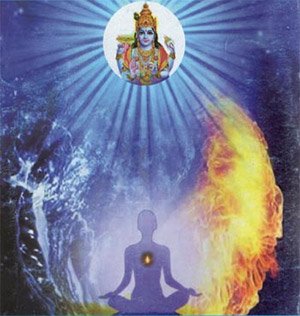Siddhanta Sangraha of Sri Sailacharya
by E. Sowmya Narayanan | 2008 | 30,562 words
Siddhanta Sangraha Chapter 4 (English translation), entitled “the origin of sense organs” as included in the critical edition and study. The Siddhanta Samgraha is a Sanskrit philosophical text dealing with Vishishtadvaita in five hundred Sanskrit verses. It was written by Shri Shailacarya (18th century) and closely follows the philosophy of Vedanta Deshika (13th century).
Chapter 4 - The Origin of Sense Organs
30. The sense organ of hearing lies in the cavity of the ear, the sense organ of touch all over the body, the sense organ of Vision lies in the eyeball and the sense organ of Taste at the tip of the tongue.
31. The sense organ of Smell at the tip of the nose. Thus, the places of the sense organs of knowledge are explained.
32- 33. The statement that the sense organs are of the nature of gross elements is in accordance with the Scriptural authority.[1] This view, namely that the sense organs are nourished by the elements is explained in the Vedārtha Saṅgraha. This is to be accepted because the inferential knowledge is over ruled by the scriptural authority. If this argument is not accepted, then in that case the statements such as paśunā yajeta etc. would become unacceptable by the wise men because they enjoy some cruel activity.
34. Hence, by an intelligent person the defect or fallacies must be understood. As all these have been elaborated in the Sarvārtha siddhi,[2] elaboration of these is avoided here.
Footnotes and references:
[1]:
The sense organs originate from the principle sātvikāhaṃkāra and are nourished by the five gross elements. Therefore, the statement that the senses are of the nature of five gross elements is to be understood only in the sense that they are nourished by the gross elements.—Vedārtha Saṅgraha. p.98
[2]:
Sarvārtha Siddhi is an auto-commentary by Desika on his Tattvamuktākalāpa. See notes no.2
Conclusion:
 This concludes The Origin of Sense Organs according to Vishishtadvaita philosophy explained by Shri Shailacarya. This book follows the model of Vedanta Deshika although the Vishishta Advaita school was originally expounded by Shri Ramanuja. Vishishta-Advaita is one of the various sub-schools of Vedanta which itself represents one of the six orthodox schools of Hindu Philosophy. They highlight the importance of the Upanishads, the Bhagavad Gita and the Brahma Sutras.
This concludes The Origin of Sense Organs according to Vishishtadvaita philosophy explained by Shri Shailacarya. This book follows the model of Vedanta Deshika although the Vishishta Advaita school was originally expounded by Shri Ramanuja. Vishishta-Advaita is one of the various sub-schools of Vedanta which itself represents one of the six orthodox schools of Hindu Philosophy. They highlight the importance of the Upanishads, the Bhagavad Gita and the Brahma Sutras.
